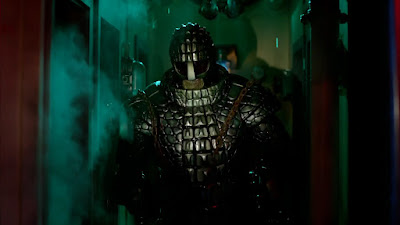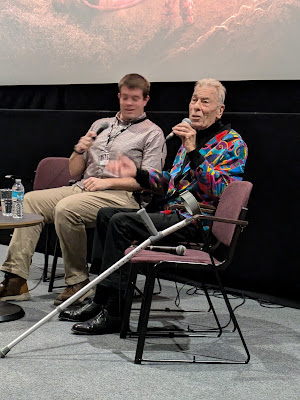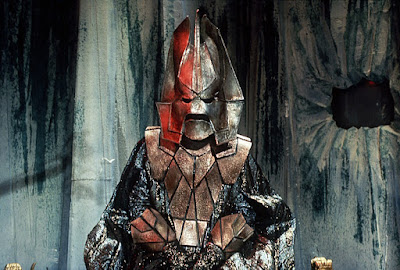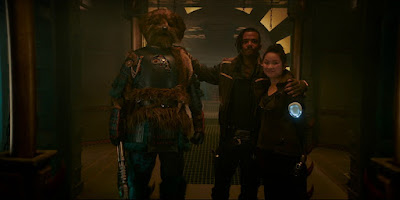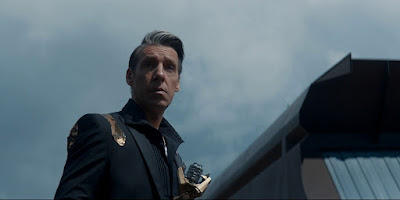Synopsis:
The TARDIS materialises on a windswept moorland. Emerging from the ship, Ben is sure from the bleak weather that they are back in Britain. They hear a loud bang, and narrowly miss being hit by a cannonball.
In a nearby cottage a group of Scots has gathered. They are led by the elderly Colin, Laird of the Clan McLaren. With him are his son Alexander, daughter Kirsty, and faithful young piper Jamie McCrimmon. They have just fled from the battlefield of Culloden, in the north east of Scotland. McLaren has been injured in the fighting. They are in hiding as the Redcoat soldiers are roaming the area, hunting for survivors. They hear someone approach.
The Doctor and his companions have come across the battlefield, and the Doctor has recognised the Jacobite emblem on a discarded hat.
They are captured by Alexander and Jamie and taken to the cottage.
Their English accents seem to condemn them, as they are suspected of being camp followers of the Duke of Cumberland, out to steal from the dead.
However, on hearing that he is a Doctor, they are asked to help the Laird.
Ben seizes a loaded pistol and holds Alexander and Jamie at bay, whilst the Doctor sets to work helping the wounded man. Once they realise the trio can be trusted, everyone relaxes - but Ben drops the pistol and it accidentally discharges.
The shot is heard by a group of Redcoats, under the command of Lieutenant Algernon Ffinch. As they approach the cottage, Alexander elects to try and lead them away. He is shot dead, and the men in the cottage are captured. Polly and Kirsty had gone out to fetch water, and remain at liberty.
Elsewhere on the battlefield a solicitor named Grey is discussing events with his clerk Perkins. Grey has been appointed Commissioner in charge of overseeing the Scots prisoners. He is unhappy that the wounded men are being slaughtered rather than captured as he has a plan to make money from the captives - by selling them as slaves in the West Indies. He has arranged for a sea captain named Trask, who has a ship at Inverness, to transport them.
Polly and Kirsty decide to try and help the others escape and cause a diversion. Ffinch wants them captured, as there is a rumour that the Jacobite leader may have disguised himself as a woman to flee the area.
Ffinch's sergeant sets about preparing to hang their captives from the cottage but the Doctor argues that he is a foreign civilian doctor, and the law protects him.
Grey has arrived and observes this, and orders that the men not be executed. He tells them that they will instead be going on a sea voyage.
Polly and Kirsty have taken refuge in a cave. They have been arguing about what to do next, with Polly unhappy at Kirsty's pessimism. She storms out onto the moor.
As she walks through the darkness, she begins to regret her impulsive actions. An owl hooting distracts her and she suddenly finds the ground giving way from under her - sending her tumbling into a concealed animal trap.
As she struggles to climb out, she sees a hand reach down towards her, gripping a dagger...
Data:Written by Gerry Davis and Elwyn Jones
Recorded: Saturday 3rd December 1966 - Riverside Studio 1
First broadcast: 5:50pm, Saturday 17th December 1966
Ratings: 6.7 million / AI 47
Designer: Geoffrey Kirkland
Director: Hugh David
Guest Cast: David Garth (Grey), Hannah Gordon (Kirsty), Frazer Hines (Jamie), William Dysart (Alexander), Donald Bissett (Colin McLaren), Michael Elwyn (Lt. Ffinch), Sydney Arnold (Perkins), Peter Welch (Sergeant).
Critique:Elwyn Jones had helped to create the police drama Z Cars, for which he wrote many of the episodes. He later became a producer, developing the Z Cars spin-off Softly, Softly, eventually becoming the head of the Drama Department. Unhappy with changes initiated by Sydney Newman, he had decided to step down from this role, to concentrate on freelance writing. With many influential friends in the Corporation, Shaun Sutton contacted various producers and asked them to consider commissioning work from Jones. One of these was Innes Lloyd, who thought that having a writer of Jones' calibre would be good for Doctor Who.
Lloyd and story editor Gerry Davis were keen to dispense with the purely historical adventures, following the poor performance of The Gunfighters. They had only reluctantly produced The Smugglers, and had intended the historicals to end with it.
However, this was the sort of story Jones wanted to write, and Lloyd felt compelled to accept this. According to Davis it was he who who suggested the Jacobite Rebellion as a setting, though Dennis Spooner recalls it differently. He was around at the time working on The Power of the Daleks rewrites, and remembers Jones already having considerable knowledge of Culloden and its context.
Jones was commissioned to write a story which would use John Prebble's 1961 book on Culloden as a basis, and the production was intended to be Troughton's third adventure. The second was at this point going to be a story involving Atlantis, written by Geoffrey Orme.
Another inspiration was the highly acclaimed docudrama about the battle written and produced by Peter Watkins for the BBC in 1964. Controversial at the time for its violence, it employed non-professional performers and presented events in a realistic newsreel style, including interviews with the combatants in character.
Davis was experiencing all manner of problems with Orme's scripts when he was asked to come and see Sutton, finding him in a meeting with Jones. The BBC had just decided to bring Z Cars back in a new twice-weekly format - and Jones had been asked to write for it, as well as for the continuing Softly, Softly.
He would no longer be able to write for Doctor Who, and had only been able to produce a few notes for his intended story.
Davis would have to take over the writing himself, though Jones would retain a credit. The story as broadcast is written by Davis alone.
The Jacobite Rebellion is often misperceived as a conflict between England and Scotland, whilst it actually owes its origins to the religious divisions between Catholic and Protestant. King Charles II had died without any legitimate heir, and so the crown had passed to his brother James. It was feared that he was going to turn the nation back to Catholicism, and this eventually led to his ousting in 1688, as Parliament invited his daughter Mary and her Protestant husband William of Orange to come to Britain and take the throne. Several attempts were made to reinstate the exiled Stuarts, including a failed French invasion in 1708 and the first Jacobite rising in 1715 - intended to place James' son on the throne as James III. The exiles eventually settled in Rome, where Charles Edward Stuart was born in 1720. He was the grandson of James II. His father had become known as the "Old Pretender", and he the "Young Pretender".
"Bonnie Prince Charlie" landed in the Hebrides in July 1745 and began raising an army. The campaign was a success initially, with the Jacobite army marching deep into England, as far as Derby. King George II appointed his son William Augustus - Duke of Cumberland - as leader of the loyalist forces. The Jacobites were forced to retreat northwards and, after a series of battles and skirmishes, the Rising came to an end at Culloden, near Inverness, on 16th April 1746.
Gerry Davis opted to use the Battle of Culloden only as a backdrop to his story, preferring to set events after the actual fighting had come to an end (mainly on budgetary grounds). Whilst setting it against a real historical event, Davis preferred to go down the literary-historical route, much as The Smugglers had followed.
The story editor had in mind especially the works of Sir Walter Scott and Robert Louis Stevenson. The latter's 1865 novel Kidnapped was a particular inspiration.
This adventure story is also set following Culloden, and involves a young Scot threatened by deportation to the Americas to be sold into slavery. We have a scene of Redcoats attacking an isolated cottage, and one of the figures is an old man who is accompanied by his daughter. The hero is a man named Allan Breck - based on a real historical figure. Patrick Troughton had portrayed him in a 1952 TV adaptation.
One of the Scots characters is Jamie McCrimmon - inspired by the real Donald Ban McCrimmon - of a Skye family famed as pipers, who were loyal to the clan McLeod of Dungaven.

Davis was helped in his writing by the director assigned to the serial. Originally slated to work on the Atlantis story, Hugh David had asked to be transferred after considering the impossible technical challenges of producing a story with underwater scenes at Riverside Studios. A successful actor - star of the Knight Errant series - in 1963 he had been first choice to play the Doctor by the programme's then producer, Rex Tucker.
Production on the serial got underway with location filming at Frensham Ponds in Surrey. Its relatively featureless moorland terrain was popular with film and television companies as it could double for almost anywhere. Doctor Who had used it for the plains of Troy in The Myth Makers.
Filming got underway on Monday 14th November. Patrick Troughton, Michael Craze and Anneke Wills had only limited time available - having to give up their day off prior to rehearsals for the Dalek story's fifth episode. As such David had to film all the location shots for episodes 1 and 4 on this day whilst he had the regulars.
Gerry Davis attended the filming, armed with a portable typewriter to make last minute changes if necessary.
The TARDIS landing site was in an area of woodland. Troughton ad-libbed his line "I should like a hat like that" on finding a feathered bonnet - a line which would form a short-lived catchphrase for the Second Doctor.
Filming carried on after dark for night scenes. Tuesday 15th November saw filming continue without the regular cast, including action sequences for this opening instalment supervised by fight arranger Peter Diamond. He had also performed speaking roles in the series - most notably Ian's friend Delos in The Romans, but also the Morok technician in The Space Museum.
Michael Elwyn struggled with his horse riding on this day, as he was filmed approaching the cottage with his soldiers.
Frazer Hines had adopted an authentic Highland accent for the filming - a higher, lilting dialect. Before going into studio he had already been approached about staying on as a regular, and realised that it would be difficult to keep this accent going in the long term. He would retain it for the studio sessions this story, then swap it for a broader Scots accent. He had spent many holidays in Scotland with relatives.
We'll discuss Hines' casting extension when we come to look at the fourth episode.
The episode went into studio at 8:30pm on Saturday 3rd December. At this stage, episodes were being recorded only two weeks before broadcast, leaving the production team very little leeway for covering emergencies.
A photocall was held earlier in the day for the main guest artist - Hannah Gordon - and for the attempted hanging sequence. A very brief clip from this sequence is one of only a couple of shots that remain in the archives for this episode, thanks to the Australian censors. There is also a clip of Alexander fighting Redcoats.
The opening credits were shown over a film sequence of the fugitive Scots hurrying towards the cottage. A 15 second piece of bagpipe music was used at various stages through the story - a traditional Pibroch lament played by Seumas O'Neill, of the Glasgow College of Piping.
The drum roll for the hanging scene was performed live in studio by extra Ken Garvie.
It was Frazer Hines' suggestion to show the party's feet in close-up - going up on tiptoe to suggest their nooses being tightened.
Troughton provided another ad-lib, abetted by Michael Elwyn. Having introduced himself as "Dr Von Wer", Ffinch asked "Dr Who?", to which the Doctor responded: "That's what I said!".
Wer - pronounced "vair" - is German for Who. This carries on Davis' apparent belief that this was indeed the character's name, as first suggested by WOTAN in The War Machines.
It is clear that Troughton is still experimenting with the role at this time. He will come across as particularly aggressive and arrogant in The Highlanders. He is dismissive of the hopes and aspirations of the Jacobites, referring to their cause as "romantic piffle" - an offensive way to treat deeply felt nationalist / sectarian feelings.
There was a certain caution about the Doctor in the last story, but here he seems to bluster his way through things.
This episode is significant as the first ever appearance by Frazer Hines as Jamie - though of course he is simply a one-off guest artist as far as the audience is concerned. Certain characteristics are already present, in terms of his loyalty and bravery.
Trivia:- The ratings for the new story begin in a less than satisfactory fashion, losing a million viewers in the week since the final episode of the Dalek story. It should be noted that weekends in December usually see families out shopping or attending festive events. The appreciation figure actually remains stable compared to the previous story.
- This episode was considered at the BBC weekly review meeting on 21st December, at which Shaun Sutton expressed his general approval. It was noted that the episode had gone down particularly well with viewers in Scotland. A sense of realism was noted, and Sydney Newman conceded that the historical stories were not popular, but this one might prove an exception.
- Jamie McCrimmon is inspired by Donald Ban McCrimmon. This family from the isle of Skye were famed as pipers, loyal to the clan McLeod of Dungaven. Unlike Doctor Who's Jamie, the real one was an enemy of the Jacobites since his clan was allied to the Hanoverian cause, and indeed he was captured and killed by Scots rebels.
- Jamie's battle cry of "Creag an tuirc" is first heard - though uttered by Alexander McLaren. It is the name of a grassy knoll near Balquhidder, where the McLaren clan used to gather. The phrase translates as "the boar's rock".
- William Dysart will return to the series in 1970 in the more substantial role of Reegan in The Ambassadors of Death.
- David Garth returned in Terror of the Autons, as the Time Lord who materialises at the radio-telescope to warn the Doctor about the Master.
- Radio Times published a pair of features to accompany the new story - a rare interview with Patrick Troughton, whom it had virtually ignored on his debut - and a piece on the story's setting.

